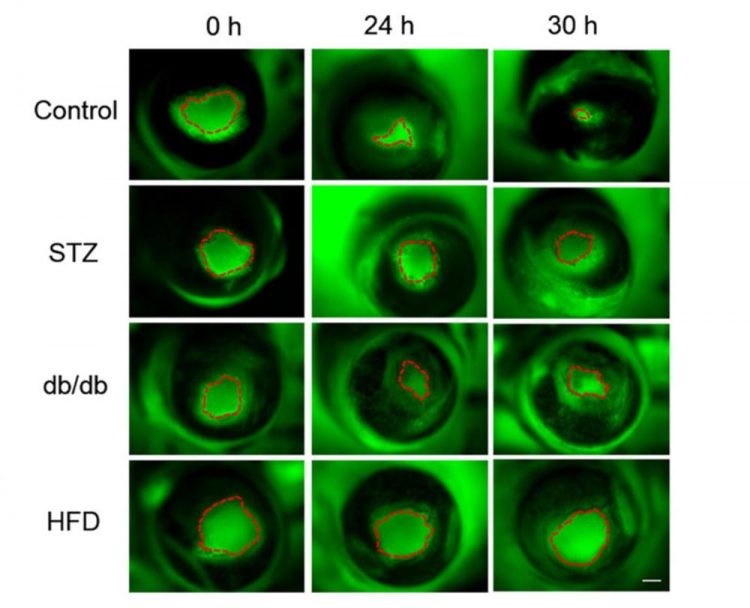Electric fields weaker in slow-healing diabetic wounds

UC Davis researchers measured electric fields and wound healing in eyes from three different models of diabetes. Left to right, green fluorescence shows damaged area shrinking over time. Top row, eyes from normal mice. Other rows are eyes from three different mouse models of diabetes. Credit: Min Zhao and Brian Reid, UC Davis
“This is the first demonstration, in diabetic wounds or any chronic wounds, that the naturally occurring electrical signal is impaired and correlated with delayed healing,” Zhao said. “Correcting this defect offers a totally new approach for chronic and nonhealing wounds in diabetes.”
It has been estimated that as much as $25 billion a year is spent on treating chronic ulcers and wounds related to diabetes, Zhao said.
Electric fields and wound healing
Electric fields are associated with living tissue. Previous work by Zhao and Brian Reid, project scientist at the UC Davis Department of Dermatology, showed that electric fields are associated with healing damage to the cornea, the transparent outer layer of the eye.
In the new work, published June 10 in the journal Scientific Reports, Zhao, Reid and colleagues used a highly sensitive probe to measure electrical fields in the corneas of isolated eyes from three different lab mouse models with different types of diabetes: genetic, drug-induced and in mice fed a high-fat diet.
In a healthy eye, there is an electrical potential across the thickness of the cornea. Removing a small piece of cornea collapses this potential and creates electric currents, especially at the edges of the wound. Cells migrate along the electric currents, closing the scratch wound in about 48 hours.
The researchers found that these electric currents were much weaker in eyes from all three strains of diabetic mice than in healthy mice. Delayed wound healing was correlated with weaker electric currents.
“We saw similar results with all three models,” Reid said.
The researchers also found that human corneal cells exposed to high levels of glucose showed less response to an electric field. Diabetics have high levels of glucose in their tears, Reid noted.
Unique facility
The UC Davis bioelectricity laboratory is one of a very few able to make such sensitive measurements of electric fields in living tissue.
“We might be the only lab in the country that is able to do this,” Reid said. They are collaborating with a number of laboratories worldwide and across the country, as well as several other UC Davis departments.
###
Other co-authors on the paper are: at UC Davis, Yunyun Shen (also at Zhejiang University, China), Trisha Pfluger, Fernando Ferreira (also at University of Minho, Portugal) and Manuel Navedo; Jiebing Liang, CSU Northridge; and Qunli Zeng, Zhejiang University. The work was supported by the National Eye Institute (National Institutes of Health) and Research to Prevent Blindness Inc.
Media Contact
All latest news from the category: Health and Medicine
This subject area encompasses research and studies in the field of human medicine.
Among the wide-ranging list of topics covered here are anesthesiology, anatomy, surgery, human genetics, hygiene and environmental medicine, internal medicine, neurology, pharmacology, physiology, urology and dental medicine.
Newest articles

NASA: Mystery of life’s handedness deepens
The mystery of why life uses molecules with specific orientations has deepened with a NASA-funded discovery that RNA — a key molecule thought to have potentially held the instructions for…

What are the effects of historic lithium mining on water quality?
Study reveals low levels of common contaminants but high levels of other elements in waters associated with an abandoned lithium mine. Lithium ore and mining waste from a historic lithium…

Quantum-inspired design boosts efficiency of heat-to-electricity conversion
Rice engineers take unconventional route to improving thermophotovoltaic systems. Researchers at Rice University have found a new way to improve a key element of thermophotovoltaic (TPV) systems, which convert heat…



